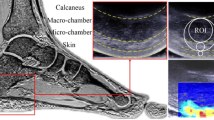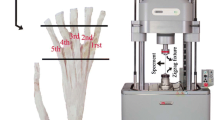Abstract
Introduction
The aim of this work was to obtain a preliminary investigation of the mechanical properties of the human plantar aponeurosis based on regional observation, in order to rationally plan a subsequent larger experimental campaign and develop suited constitutive models to characterize the mechanical response of this tissue.
Materials and methods
Different in vitro mechanical tests were developed on eleven samples taken from the plantar aponeurosis of human cadaver (man, age 78 years). The samples were tested along the distal–proximal direction. Range of elasticity of the tissue, development of damage phenomena and stress relaxation at different levels of strain were evaluated.
Results
The strength of the tissue was found in the order of that proposed in previous works, with peak stress of about 12.5 MPa. The compliance of the plantar aponeurosis was in line with in vivo evaluation. A softening behaviour appeared for tensile strain larger than 12%. In relaxation tests, the stress was reduced of 35–40% in 120 s. The percentage stress relaxation was found independent on the level of the applied strain.
Discussion
The evaluation of the mechanical characteristics is fundamental for a subsequent development of numerical models of the plantar aponeurosis. Such approach is helpful to understand its response to overuse, but also to understand the clinical results of different manual and physical therapies that use warm, pressure or stretch to modify this tissue.







Similar content being viewed by others
References
Actis RL, Ventura LB, Smith KE, Commean PK, Donovan JL, Pilgram TK, Mueller MJ (2006) Numerical simulation of the plantar pressure distribution in the diabetic foot during the pushoff stance. Med Biol Eng Comput 44:653–663
Boukerrou M, Boulanger L, Rubod C, Lambaudie E, Dubois P, Cosson M (2007) Study of the biomechanical properties of synthetic mesh implanted in vivo. Eur J Obstet Gyn R B 134:262–267. doi:10.1016/j.ejogrb.2007.02.023
Cheung JTM, Zhang M (2005) A 3-dimensional finite element model of the human foot and ankle for insole design. Arch Phys Med Rehabil 86:353–358. doi:10.1016/j.apmr.2004.03.031
Dressler MR, Butler DL, Wenstrup R, Awad HA, Smith F, Boivin GP (2002) A potential mechanism for age-related declines in patellar tendon biomechanics. J Orthop Res 20:1315–1322. doi:10.1016/S0736-0266(02)00052-9
Erdemir A, Hamel AJ, Fauth AR, Piazza SJ, Sharkey NA (2004) Dynamic loading of the plantar aponeurosis in walking. J Bone Joint Surg Am 86-A:546–552
Gefen A (2003) The in vivo elastic properties of the plantar fascia during the contact phase of walking. Foot Ankle Int 24:238–244
Hicks JH (1954) The mechanics of the foot. II. The plantar aponeurosis and the arch. J Anat 88:25–30
Iatridis JC, Wu J, Yandow JA, Langevin HM (2003) Subcutaneous tissue mechanical behavior is linear and viscoelastic under uniaxial tension. Connect Tissue Res 44:208–217
Kitaoka HB, Luo ZP, Growney ES, Berglund LJ, An K-N (1994) Material properties of the plantar aponeurosis. Foot Ankle Int 18:8–15
Kitaoka HB, Luo ZP, An KN (1997) Effect of plantar fasciotomy on stability of arch of foot. Clin Orthop Relat Res 344:307–312. doi:10.1097/00003086-199711000-00031
Kitaoka HB, Luo ZP, An KN (1997) Mechanical behavior of the foot and ankle after plantar fascia release in the unstable foot. Foot Ankle Int 18:8–15
Kogler GF, Veer FB, Solomonidis SE, Paul JP (1999) The influence of medial and lateral placement of orthotic wedges on loading of the plantar aponeurosis. J Bone Joint Surg Am 81:1403–1413
Kubo K, Kanehisa H, Kawakami Y, Fukunaga T (2001) Influence of static stretching on viscoelastic properties of human tendon structures in vivo. J Appl Physiol 90:520–527
Kubo K, Kanehisa H, Fukunaga T (2002) Effect of stretching training on the viscoelastic properties of human tendon structures in vivo. J Appl Physiol 92:595–601
Kureshi A, Vaiude P, Nazhat SN, Petrie A, Brown RA (2008) Matrix mechanical properties of transversalis fascia in inguinal herniation as a model for tissue expansion. J Biomech 41:3462–3468
Murphy GA, Pneumaticos SG, Kamaric E, Noble PC, Trevino SG, Baxter DE (1998) Biomechanical consequences of sequential plantar fascia release. Foot Ankle Int 19:149–152
Natali AN, Pavan PG, Carniel EL, Lucisano ME, Taglialavoro G (2005) Anisotropic elasto-damage constitutive model for the biomechanical analysis of tendons. Med Eng Phys 27:209–214. doi:10.1016/j.medengphy.2004.10.011
Natali AN, Pavan PG, Carniel EL, Dario P, Izzo I (2008) Constitutive formulation of soft tissue mechanics with ageing. IEEE Eng Med Biol Mag 27:15–22. doi:10.1109/MEMB.2008.919492
Natali AN, Forestiero A, Pavan PG, Carniel EL, Dal Zovo C (2010) Investigation of foot plantar pressure: experimental and numerical analysis. Med Biol Eng Comp 48:1167–1174. doi:10.1007/s11517-010-0709-8
Natali AN, Pavan PG, Stecco C (2010) A constitutive model for the mechanical characterization of the plantar fascia. Connect Tissue Res 51:337–346. doi:10.3109/03008200903389127
Salathe EP Jr, Arangio GA, Salathe EP (1986) A biomechanical model of the foot. J Biomech 19:989–1001
Sarrafian SK (1987) Functional characteristics of the foot and plantar aponeurosis under tibiotalar loading. Foot Ankle 8:4–18
Sasaki N, Odajima S (1996) Elongation mechanism of collagen fibrils and force–strain relations of tendon at each level of structural hierarchy. J Biomech 29:1131–1136. doi:10.1016/0021-9290(96)00024-3
Schechtman H, Bader DL (1997) In vitro fatigue of human tendons. J Biomech 30:829–835. doi:10.1016/S0021-9290(97)00033-X
Schechtman H, Bader DL (2001) Fatigue damage of human tendons. J Biomech 35:347–353
Taylor DC, Dalton JD, Seaber AV, Garrett WE (1990) Viscoelastic properties of muscle-tendon units. The biomechanical effects of stretching. Am J Sports Med 18:300–309. doi:10.1177/036354659001800314
Wang JH-C (2006) Mechanobiology of tendon. J Biomech 39:1563–1582. doi:10.1016/j.jbiomech.2005.05.011
Wright DG, Rennels DC (1964) A study of elastic properties of plantar fascia. J Bone Joint Surg Am 46:482–492
Acknowledgments
The authors are grateful to CARIPARO Foundation (ITALY) for the funding the mechanical testing instrument that was adopted in this work.
Author information
Authors and Affiliations
Corresponding author
Rights and permissions
About this article
Cite this article
Pavan, P.G., Stecco, C., Darwish, S. et al. Investigation of the mechanical properties of the plantar aponeurosis. Surg Radiol Anat 33, 905–911 (2011). https://doi.org/10.1007/s00276-011-0873-z
Received:
Accepted:
Published:
Issue Date:
DOI: https://doi.org/10.1007/s00276-011-0873-z




